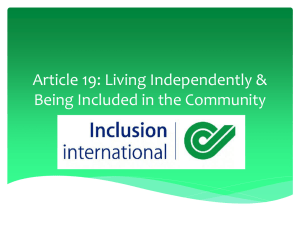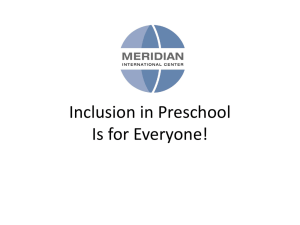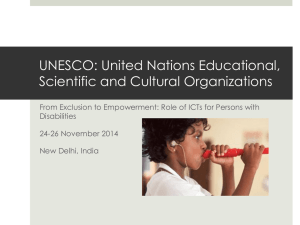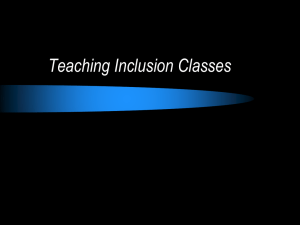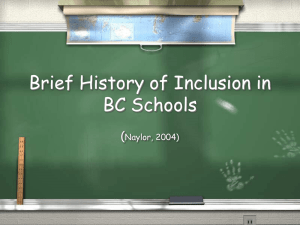Preparing Teachers for Inclusion in Higher Education
advertisement
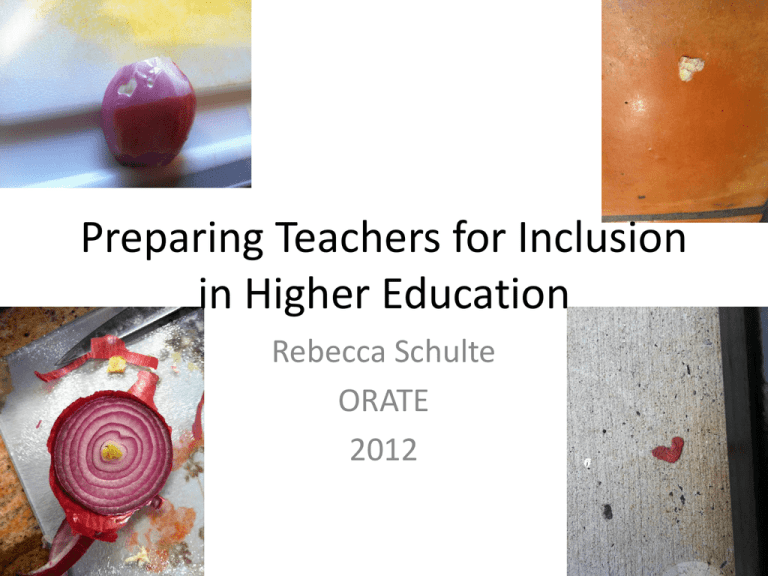
Preparing Teachers for Inclusion in Higher Education Rebecca Schulte ORATE 2012 In a sense, each of us is an island. In another sense, however we are all one. For though islands appear separate, and may even be situated at great distances from one another, they are only extrusions of the same planet, Earth ~ J. Donald Walters “Inclusion” • A process: Successful inclusion defined as meaningful participation of students with disabilities in social and academic activities within the general education classroom, to include flexible grouping, cooperative learning, peer support and activity-based learning (Janney & Snell, 1996). • A place: "The least restrictive environment is the one that, to the greatest extent possible, satisfactorily educates disabled children together with children who are not disabled, in the same school the disabled child would attend if the child were not disabled.” (IDEA, 1997/2004) • A disposition: Udvari-Solner (1996) describes full inclusion as “a value-based practice that attempts to bring students, including those with disabilities into full membership within their local school community” (p.101) At least 53.7% of all students with disabilities are in general education classrooms 80% or more of each day (30th Annual Report to Congress, 2008) Inclusion is not….. D.R.O.D.I.J.R.F. • Dumping students with disabilities into general classrooms without careful planning and adequate support. • Reducing services or funding for special education services • Overloading any classroom with students who have disabilities or who are at risk. • Disproportionate amount of time teaching or adapting curriculum for students with disabilities. • Isolating students with disabilities, socially, physically or academically within the general education classroom. • Jeopardizing the achievement of general education students through slower instruction or less challenging curriculum. • Relegating special education teachers to the role of assistant in the general education classroom • Forcing general and special education teachers to team together without careful planning and well defined responsibilities. McLesky, 2000 Research General education teachers lack adequate time, training and resources for inclusion (Scruggs & Mastropieri, 1996) Students with disabilities in inclusive settings outperform their segregated peers with disabilities ( Blackorby et al 2005) Special education teachers don’t feel prepared to work in inclusive settings or collaborate (Scheurmann et al. 2003). Both general and special education candidates need to be prepared for inclusion and collaboration in teacher education programs (Valli & Buese, 2007) The problem: • The most frequently cited reason for resistance to inclusion is the lack of skills necessary to teach students with disabilities (Mink, Bear, Deemer and Griffin, 1996) • Professional development in school in the areas of inclusion and collaboration are generally not effective in making inclusion successful (McLesky & Waldron, 2004). • Teacher preparation programs lack coursework and field experience for preparing both general and special education candidates for inclusion and collaboration (Ramsey & Simon, 2005; Harvey, Yssel, et al 2010) Successful Inclusion • Successful inclusion is a mindset, a cultural paradigm, good for all students • Successful inclusion depends upon positive attitudes toward diversity, toward students with disabilities, teaching efficacy, and collaboration (Buell & Gamel-McCormick, 1999). • Effective teaching is effective intervention for all students (Jordan & Stanovich, 1998) Priorities of National Policy • Special education students are first and foremost general education students. The students (and their IEPs) are the responsibility of general education teachers • General and special education are integrated and include high quality instruction based on evidence-based practices • Early identification and prevention prior to referral for special education • Inclusive classroom communities that embrace diversity • Accountability measures that acknowledge teachers for all student growth, including that which is below grade level • Linking highly qualified status to performance that shows effective teaching of diverse students May, 2011 “We will set a clear goal: Every student should graduate from high school ready for college and a career, regardless of their income, race, ethnic or language background, or disability status.” — President Barack Obama, A Blueprint for Reform: Reauthorization of the Elementary and Secondary Education Act, March 2010 Reinvigoration of Teacher Education based on federal policy, state policy, and teacher preparation program standards (goals of AACTE, 2011) 1. All teachers are prepared to act on the belief that all students, including students with disabilities, belong in general education classrooms. 2. All teachers are prepared to treat all students, including students with disabilities, as capable learners who are entitled to high-quality instruction and access to challenging content that fully prepares them for careers and postsecondary education. 3. All teacher candidates complete their initial preparation with the knowledge and skills necessary to successfully enter the profession and meet the instructional needs of students with disabilities. 4. State and federal policy invest in high-quality teacher preparation for all candidates, while assuring that every new teacher is qualified with demonstrated skill to educate students with disabilities. 5. All providers of teacher education embrace preparation for diverse learners as a core component of their mission, prioritizing it, strengthening it, and funding it accordingly. Goal #1 All Teachers Believe……… • ..that general education teachers should accept responsibility for educating all students, including students with disabilities • ..that disability is a part of human diversity versus a deficit • ..in different ways of learning and that students with disabilities can learn to the best of their ability • ..in their own ability to teach students with disabilities (self-efficacy) • ..in equal and supportive partnerships between general and special education teachers AACTE, 2008 • ..that inclusion can be successful Goal #2 All Teachers are Prepared… AACTE, 2008 …to understand exceptionalities …to differentiate instruction …to implement principles of universal design …to hold all students to high standards …to use evidence-based teaching practices …to use of Multi-Tier Systems of Supports (RTI) …to collaborate Goal #3 All teacher candidates show evidence of being prepared for inclusion • General education teachers show evidence of an ability to teach a diverse group of students • Special education teachers show evidence of core knowledge and general education curriculum • Quality field experiences with diverse learners by way of strong school-university partnerships • Opportunities for collaborative teaching (btw gen ed and sped) Goal # 4 Policy “invests” in inclusion • Reduce variability in how teachers are prepared across different states • To promote proficiency in teaching students with disabilities (Higher Ed Act, 2008) federal policies require states to report on teacher quality, and; – The extent general education candidates are prepared to teach diverse students and be a member of IEP teams for students with disabilities – The extent special education candidates receive core academic coursework and pedagogy for teaching academic subjects • Federal Grants for program offer incentives for program redesigns •All graduates get both a general and Special education license •Completely unified curriculum •Common core curriculum •Specialization follows general education license •And is built upon a common base of knowledge •“Dual certified” but are two unrelated tracks •Does not forward an inclusive agenda •Perpetuates separation between general and special education Infusion Vs. • Content related to collaboration or inclusion is embedded in the existing curriculum • Preferred by TEP because it “does not necessitate the creation of new courses or the deletion of existing content" (Cook, 2002, p. 275). • Not recommended because it is unlikely that instructors of all courses within an infusion model will have sufficient expertise to satisfactorily address all topics and skills related to collaboration • Infusion approach has been criticized for its ineffectiveness in developing collaborative skills (Stayton & McCollum, 2002). Embedded • Embedded design involves creating selfrepeating patterns in a system by expressing the essential features of collaboration and / or inclusion at many levels. (Waldrop, 1993) • Embedded design occurs at four levels, 1. first introduced at a knowledge and awareness level 2. then in skill building through active experience, in "real world" application with feedback 3. and then at a personal impact or consequential level as part of the course assessment. Goal # 5 for Teacher education programs • Reach consensus about appropriate entry level for teacher candidates • Examine and possibly reduce the number of alternative certification practices. • University investment in faculty engagement in clinically-based practices and partnerships • Make national board certification a goal for all teachers • Rethink the roles of general and special educators. • Maintain a “principled, rights-based approach” built on a set of values that include a respect for diversity. What all Teacher Candidates need…… (Olson et al, 1997; Villa, Thousand, Meyers, & Nevin, 1996) • To be able to transcend traditional roles and functions • High levels of tolerance, reflection, and flexibility • Positive responses to students with disabilities • Knowledge and skills for adapting and differentiating curriculum and instruction Best Practices for Inclusive Classrooms • • • • • • • • • • Differentiated instruction Universal Design for Learning Cooperative Learning Explicit Instruction Variable groupings Collaborative planning and teaching Team-teaching Cooperative teaching (Idol, 2006) Peer-coaching Clarity of roles and expectations (Friend, Reising, & Cook, 1993; Salend, 2008) Room for Improvement for Teacher Education … • Preservice teachers are not prepared for differentiation (Dee, 2011). • Teacher education programs perpetuate the cultural divide with separate programs of education (Utley, 2009 ). Categorical training leads to categorical thinking • Less than one half of all special educators and less than one third of general educators take a course on collaboration within their pre-service training (Griffin et al., 2006) • Fewer than 11% of teacher preparation programs report requiring collaboration as part of the field experience for teacher candidates. • Future teachers need to be exposed to faculty and curricula that not only support collaboration but also reflect it (Kamens, 2007) Recommendations for Teacher Education • Teacher education programs have better funding • Faculty in teacher education be rewarded for involvement in clinical preparation • Re-imagine the role of special education faculty • Reduction of silos in teacher education and innovations in coordination of strong clinical experience teaching diverse students • Support for research in teacher education • Faculty explore our own biases, assumptions, attitudes, inclusiveness, and silo–ness Higher Education Opportunity Act (HEOA, 2008) • Strong emphasis on preparing general education teachers to teach students with disabilities. • HEOA increases federal oversight in higher education • Included in HEOA are provisions ensuring that all teacher candidates are skilled in the methods used in response to intervention, positive behavioral interventions and supports, and universal design for learning. • New HEOA grant programs, including Teach to Reach, provide incentives for teacher education programs to prepare a variety of professionals to support students with disabilities. As Sapon-Shevin (2003) so eloquently says, “Inclusion demands that we ask, what kind of a world do we want to create, and how should we educate students for that world?” (pg 26).
